Soviet Hetzers
Strictly speaking, story Soviet tank destroyer began even before the attack of fascist Germany. In April 1941 of the year at a meeting of KOs at SNK of the USSR, when plans for the release of the T-50 tank for the current year were discussed, on the initiative of Marshal G. Kulik, "because of the unavailability of the 57-mm tank gun for the T-50 tank", the question and was raised at the meeting. .. about the development of a fighter tank armed with an 50-mm high-power cannon armament on the T-57 chassis. 1941 (ZIS-2), as well as an anti-aircraft tank with 25-mm, or 37-mm automatic for the protection of tank units on the march and in deployment from the attack of enemy tanks and aircraft. " May 19 1941 S.Ginzburg reported in his letter to the marshal about the developed by the design team of the Department of the Chief Designer of the plant number 174 them. Voroshilov (project manager Naumov) on the draft design of such a fighter tank. In his report, in particular, stated:
This will allow to maintain a high degree of protection for the crew behind armor plates located at large angles of inclination and will not worsen the operating conditions. 57-mm gun of high power can be installed in the front sheet of the tank or in a special armored superstructure with the ability to fire in a horizontal plane to 45 degrees. The commander’s observation tower must be preserved ... The absence of a rotating turret in a fighter tank is undoubtedly one of its shortcomings, but only in this case the speed of development can be significantly reduced and kept within the rigidly defined comrade. People's Commissar of the time ... Such a reckless tank will undoubtedly be much more powerful, cheaper, less noticeable and easier than any other modern tank, which is in service with the spacecraft ... "
Unfortunately, no images of the project of the Soviet "Hetzer" could be found, as is unknown, and the decision made by the higher authorities about it. And with the start of the war, the 174 plant was preoccupied with the rapid development of the T-50 tank, then twice went into evacuation and, most likely, the work on this “fighter tank” was no longer carried out.
We need to stay a little more near the power plant of the T-50 tank. Indeed, in 1940, a special in-line diesel engine B-4 (which was, as it were, the “half” of the famous B-2) was developed for it, which was supposed to be put on light tanks and tracked tractor in 1941 – 42. Among the shortcomings of the B-4 engine, all designers attributed its mandatory vertical location, which complicated its placement in the hulls of light tanks. However, this engine has a displacement of 11,9 liters and a nominal horsepower 225. at 1750 rpm was very attractive for the domestic industry due to its high degree of unification with the 12-cylinder B-2. However, before the war, plant number 75 and its mass production has not mastered.
Also in 1940, plant No. 185 completed the development of the diesel engine No. 744, the main feature of which was that it was entirely placed in place of the standard engine of the T-26 tank. It was a four-stroke four-cylinder diesel water cooling rated power hp 150. at 1700 rpm The diesel engine was intended primarily to equip the T-26-1 tanks and the combat vehicles created on its base, during their large-scale modernization in the 1941-43 years. However, its production in 1941 was not mastered, and during the war, not a single engine factory that tried to organize its production could not start producing fuel pumps, and therefore engines as a whole.
Practically all the first projects of SAU, proposed during the war, were considered as universal artillery means of supporting tank units or infantry, aimed primarily at fighting enemy tanks. These were mostly peculiar cheap "tanks without a tower", which could be produced in large quantities on existing equipment with available forces.
In the fall of 1941, Plant No. 174 proposed to launch the production of a “fighter tank” based on T-26 units, especially those that needed repair. To do this, it was proposed that the tank dismantle the turret with weapons, and install an X-NUMX-mm F-76 cannon in the armor superstructure of the hull (which was manufactured by the Leningrad Kirovsky Plant). The project was accepted for execution, but soon began evacuation of the IZ, LKZ and the plant. Voroshilova stopped work on it.
3 March 1942, the creation of light SAUs was launched by NKTP on the initiative of the newly appointed chief of the special bureau of OGK NKTP S. Ginzburg. In the conceptual design, the special bureau proposed to use for the ACS a unified chassis from the units of the T-60 light tank and trucks. However, there were no “Hetzer-like” machines in this inflorescence, and until the autumn of 1942, NKTP practically did not return to the question of the deployment of works on the creation of ACS. As L.Gorlitsky wrote, “There were enough other worries then.”
But already in April, 1942, with the initiative of organizing the production of special anti-tank SAU, was made by the NKV. It is interesting to note that in the task for the development of these SAUs they were called “assault anti-tank guns,” and the following features were specifically mentioned:
“1. Have the lowest possible silhouette (preferably at the level of an average person's height)
2. Use the cheapest units of mass-produced light tanks, trucks and tractors.
3. As a power plant to have the ability to install mass-produced automobile engines, from among those well mastered by industry.
4. Have as few crew members as possible, no more than 3 people.
5. Have weapons capable of piercing armor 500 mm and more in thickness at a distance of 50.
6. The armor protection of the ACS should provide reliable protection of the vehicle against 37-mm anti-tank guns from frontal angles at all distances of real fire. The sides and feed of the self-propelled gun should protect the crew from bullets of large-caliber machine guns, light PTR, as well as fragments of shells, bombs and mines. "
Design teams NII-13, MVTU im. Bauman, NATI, TsAKKB, Uralmashzavod, and also related enterprises from NKTP: plant No. 592, GAS, OKB 38 and a number of others.
In the summer of 1942, SRI-13 presented a draft design of several variants of tank destroyers on the chassis from units of light tanks T-60 and T-70. The designs of three such machines differed from each other mainly in the armament only. A special feature of these self-propelled guns was a low-height armored hull made by welding from rolled armor plates with a thickness of 35-15-mm. Armor at large angles of inclination provided a small crew (3 man in linear ACS or 4 man in commander) good protection from the fire of German 37-mm TAP and 50-mm tank guns with 42 barrel length caliber, that is, the most massive guns in caliber army right up until the second half of 1942. It was proposed to borrow the engine and the transmission from the ZIS-5 car, and it was intended to bring its power to the HP 108. by forcing. It was also interesting that the relatively small size of the combat compartment should not have tired up the crew during long marches, since on the march the hull roof leant to the sides in the form of additional sides, opening the combat compartment from above. At the same time, these additional sides served to protect the crew from bullets and shell fragments on the march.
The first car, the 13.73-SU, was armed with a 45-mm high-power cannon developed at SRI-13 in the 1941 year, which was similar to the X-NUMX-mm M-45 cannon later adopted.
The second car under the designation I13.75-SU was armed with two twin 45-mm guns, the same as on the first machine.
The third machine under the designation И13.76-SU was armed with an 76-mm "self-propelled" gun with a caliber 50 barrel, which was converted into a research institute-13 from the F-22 divisional gun.
All of the artillery systems were supposed to be equipped with a special “lightweight-type fork frame” with a splinter shield and a telescopic sight.
The projects were reviewed at the meeting of the technical committee of the NKV, and in October of the 1942 of the year, the TsAKB was connected to work to refine the artillery unit, and the OKB-33 and KB NATI were commissioned to work out the motor group.
In December 1942 of the year, the finalized projects of the ACS were presented to the senior executives, and the machine equipped with the 76-mm cannon personally liked JV Stalin, who called it “extremely interesting”. And by order of the GOKO from 16 in January, the NKTP and NKV were instructed to produce and submit for testing by February 15 the prototypes of two military vehicles NII-13, which were assigned the conventional index SU-IT-45 and SU-IT-76 (Self-propelled unit - tank destroyer, respectively 45-mm and 76-mm gun).
But at the beginning of 1943, it turned out that there were difficulties with the production of ZIS-80-type forced engines, and the GAZ-203 twin-engine unit, which was in the T-70 tank, does not get into the engine compartment of the new cars. Required to redesign the engine compartment and gearbox.
True, it was expected that soon either the Engine of the Revolution plant or the Yaroslavl plant were about to start production of V-3 or No. 744 diesel engines, which were urgently needed to equip light tanks, self-propelled guns and artillery tractors. The use of diesel power of 150-250 hp at 1700–1800 rpm, it would be possible to increase the armor protection of the self-propelled guns to 45–25 mm. But new diesel engines were not mastered, since in 1941–42 these plants were seriously damaged during the German attack. aviation, and also experienced an acute shortage of qualified personnel. Production under license in the USSR of American diesel engines with a capacity of 110–160 hp also not yet begun. Therefore, it is clear that the SU-IT-76 project, which was repeatedly processed for different engines, was not completed on time.
In addition, the seizure near Leningrad and the testing of the new German Tiger tank demanded that the designers envisage strengthening the armament of the ACS. On the recommendation of the chief of the TsAKB V.Grabin, a simplified 57-mm C-1-57 cannon with ballistic ZIS-2 was installed in the car. Calculations showed that a simple replacement of the barrel in the new SAU is indispensable; it was necessary to change the design of the installation elements. Therefore, the manufacture of the experimental self-propelled guns was once again suspended until the deficiencies were fixed and deadlines agreed, and the armored corps of the failed tank destroyer in the fall of 1943 was handed over to the Moscow branch of the SRI-48, where it was used at the end of the war mainly as a target for testing new captured armor-piercing ammunition.
Since the fall of 1943, NII-13 has not returned to work on the creation of self-propelled anti-tank artillery, although several times during the year he tried to push his brainchild into service of the Red Army.
Following the designers of the NKV, the designers of GAZ, headed by N. Astrov, followed the path of creating a special light tank destroyer. In the summer of 1943 of the year, they, jointly with the Bureau of National Institute of Architecture and Architecture, prepared two projects of armored SAU, which appeared in correspondence on the People's Commissariat of the tank industry, as “reckless GAZ-74 fighter tanks”. Between themselves, these two self-propelled guns differed in the location of the combat compartment. In the first car, the GAZ-74, the fighting compartment was to be located in the rear of the vehicle in the GAZ-71 type and already equipped with the SU-12 (better known as the SU-76), which improved the mass distribution of the ACS to the support rollers, raised the maneuverability, however, it had to pay a relatively large silhouette and weight of the car.
The second option (GAZ-74b) was very similar to SU-IT-76, proposed by SRI-13. The car had a low silhouette, good booking (in the frontal part - 45 mm) with an inclined arrangement of armor plates and armed with a 76-mm C-1 cannon (the same gun stood on the serial SU-76). The new fighter was also to receive a GMC-71 diesel engine.
GAZ-74b was built, factory tested, was generally approved by the military and even under the symbol SU-76-I (not to be confused with SU-76i) or SU-74 allowed to state tests. However, in the 1943, the armament of such machines 76-mm cannon with a barrel length 41 caliber was considered insufficient for the fight against German heavy tanks, and the cost of this SAU was much higher than the cost of the serial SU-76, which has already been mass produced. Therefore, the fate of GAZ-74b was resolved at that moment.
In the summer of 1943, the Gorky Artillery Plant No. 92, with the submission of the Chief of the Central Design Bureau, V. Grabin, supported by D. Ustinov, resumed the production of 57-mm anti-tank guns ZIS-2, as well as their tank versions ZIS-4, terminated at the end of 1941 of the year. These guns had very good armor penetration rates. This circumstance again prompted the designers to create anti-tank SAU. Already in early August 1943 of the gate of the plant number 38 for factory testing was released by the SU-57 machine, which was a serial SU-76M with the 57-mm anti-tank gun SU-15-57 installed instead of the standard 76-mm gun.
According to the test results, the ACS was not recommended for use. First, it turned out that the recoil length of the 57-mm guns exceeds the norms specified by the customer. In addition, the military motivated the refusal of the SAU by the fact that tank destroyers should, in their opinion, have a closed armored hull counter booking and a diesel engine.
October 29 1943, the students of MVTU also proposed a design of an armored tank destroyer, resembling both the 13.75-SU and GAZ-74b. It was assumed that it will have a mass of no more than 11 tons, will receive a diesel engine GMC-71 or similar, about the organization of production of which in the USSR at that time were active discussions. The machine will be armed with either an X-NUMX-mm C-76 cannon, or an 1-mm C-57 – 1. The crew will be 57 person. Despite the fact that all the formal requirements of the military project were satisfied, the order for its production was not followed.
Meanwhile, GAZ persistently continued work on the tank destroyer. And there was both the creation of a new GAZ-74b with the 57-mm long-barreled C-1 – 57 gun, and the improvement of the machine equipped with an 76-mm cannon (for it, the CNXX-mm high-power cannon with the barrel length of about 76 gauges).
In order to distinguish the GAZ product armed with an 57-mm cannon from an ACS manufactured by plant No. 38, the conditional index SU-57b was first given, while the tested machine of plant No. 38 (SU-76M, re-equipped with a ZIS-2 gun) was named in correspondence on NKTP as SU-57a.
Despite the fact that SU-57b passed almost all the proposed tests, it was not accepted for service. Among the reasons for non-adoption, the high cost of self-propelled guns, the need to produce a new diesel that was not mastered by domestic industry were called (to depend on foreign supplies in a war would be the height of unreason).
Has contributed to the creation of the domestic tank destroyer and the CB NATI. Apparently, taking into account the experience of working on the GAZ-74, they also developed their own version of a turretless fighter, and it is interesting that the project in correspondence went under the heading “hunter” (for comparison, Hetzer in German, “huntsman” is a hunter who honors animals). When ready, this tank destroyer armed with an 57-mm gun was tested. But this car also did not receive the required engine, and in terms of the complex of combat characteristics and price, it differed little from the samples of the GAZ plant, which were actively promoted at all levels. The car was tested and refined several times, but it was never accepted for service.
Work to improve the GAZ-74 in 1944 year led to the creation of an improved ACS, which received the index GAZ-76d, or SU-76d ("diesel"). True, the C-54 gun was never received for it, but the armor in the frontal part was brought to the thickness of 60 mm and, in this form, with the 76-mm cannon C-1 was allowed to state tests under the SU-80 index. But it was not put into service again due to the lack of clear advantages over the serial SU-76 and because of the presence of imported diesel, the production of which was not mastered either in Yaroslavl, or in Miass, or during the repeated bombing of the Gorky Automobile Plant in 1943. .
It is interesting to note that at the beginning of 1945, the Hetzer ACS captured in Hungary was tested in conjunction with SU-57б, and the conclusion was:
“Thus, the German experience in tank building shows that the use of small-sized reckless tanks in modern warfare has fully justified itself ... Comparing the German turretless tank of the" wasp "type with the SU-57b machine of the Gorky plant, having a similar mass, shows some of the advantages of a domestic machine connected with the use of a diesel engine ... The installation on the roof of a German tank defensive machine gun with the ability to fire because of armor should be considered very successful ... The disadvantages of the SU-57b include the absence in her ammunition of a powerful high-explosive or high-explosive fragmentation projectile ... "
During the 1943 – 44 years, work on domestic “coffins” came to its logical end. This is understandable, since tanks with an 85-mm cannon were already in service, the shells of which had a great armor penetration and a more powerful high-explosive effect. But the main thing - the need for such pronounced defensive machines was no longer so acute as in 1941 – 42.
Toward the close of this story, the Gorky people nevertheless created another anti-tank SAU GAZ-75, which became, as it were, the last chord - the crown among the Soviet Hetzer. It was interesting that with a combat mass of no more than 18 tons of GAZ-75 carried frontal armor 75 – 90 millimeters thick (whereas the serial SU-85 - only 45 mm) and was armed with the same 85-mm gun as the T-34 -85 and SU-85. The location of the fighting compartment in the middle of the ACS improved the mass distribution to the track rollers and improved cross-country maneuverability. At the same time, the successful SAU gearbox made it extremely mobile both on the highway and on rough terrain. But the weapons and this ACS still did not get ...
In 1945, a large number of materials on promising models of military equipment fell into the hands of Soviet troops; they were worked on in fascist Germany and were not completed during the war. Among them was a very interesting project “Hetzer Starr”, which differed from its counterparts in the original installation of artillery guns, which had a tight connection with the hull, which, according to German designers, made it possible to abandon recoil devices, saving the internal space of the fighting compartment, and also somewhat increased the rate of fire artillery systems. The advantages of the system, our experts also attributed its low cost.
Therefore, in November 1945, it was decided to create a special design team of German specialists to study and refine the project in order to be able to use it for the needs of the Soviet Army. The SAU project was completed in the summer of 1946, and according to some data, even the production of a prototype began. It is interesting to note that M. N. Schukin (chief designer of the OKB-38) was one of the chairmen of the mock-up commission for this product.
But the work on the SAU was stopped due to the fact that the power of the 75-mm anti-tank gun to fight enemy tanks was clearly not enough, and the use of more powerful artillery systems was problematic, since they had a very large recoil response to the chassis and the SAU body, the more have really appeared recoilless guns of greater power.
The century of the Soviet Hetzer is over.
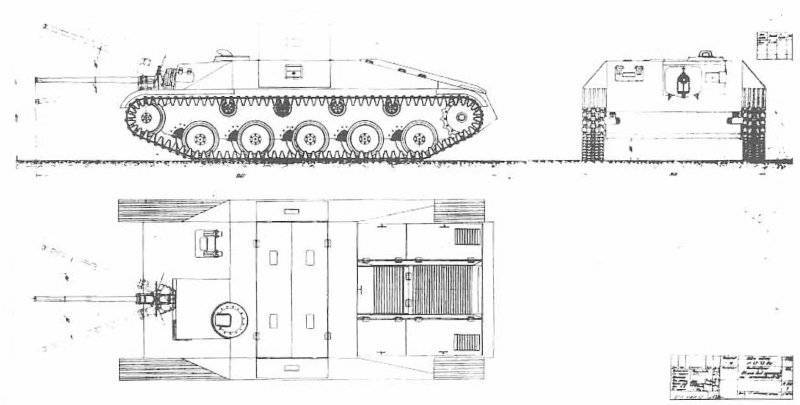
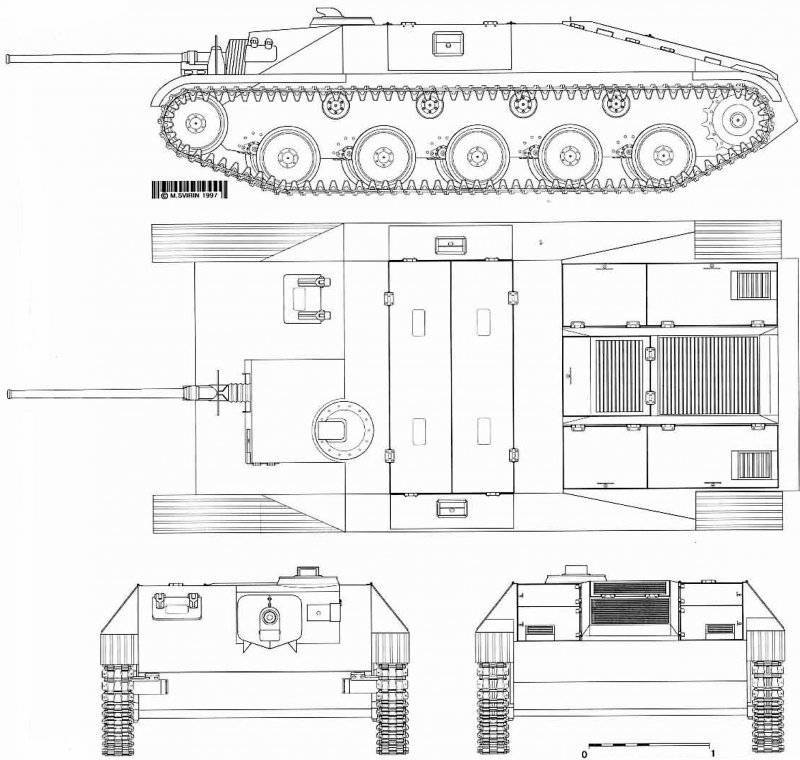

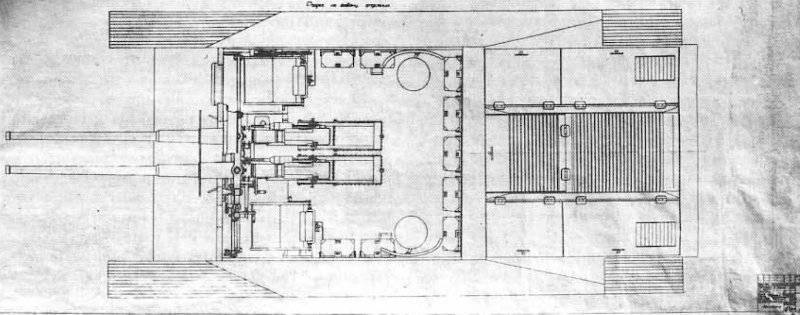
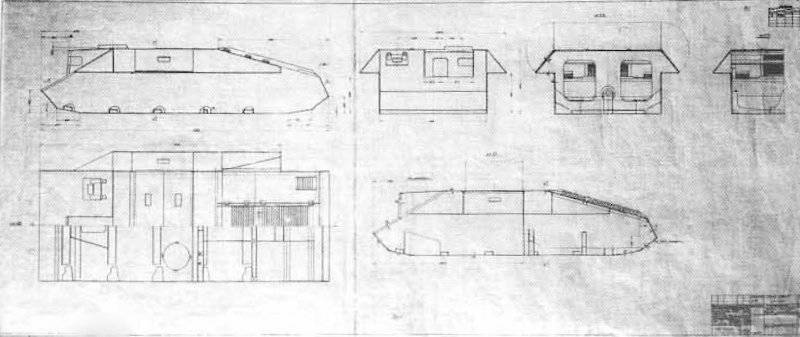


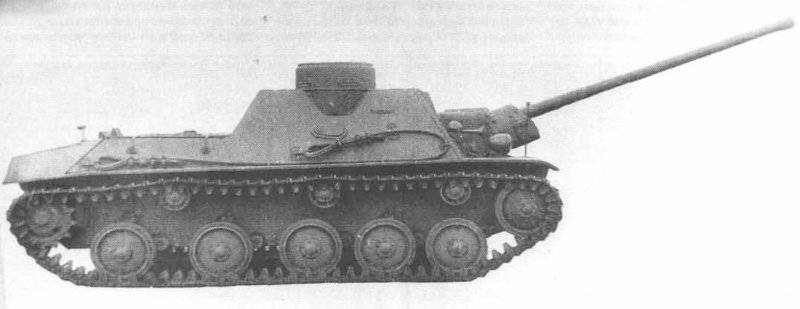
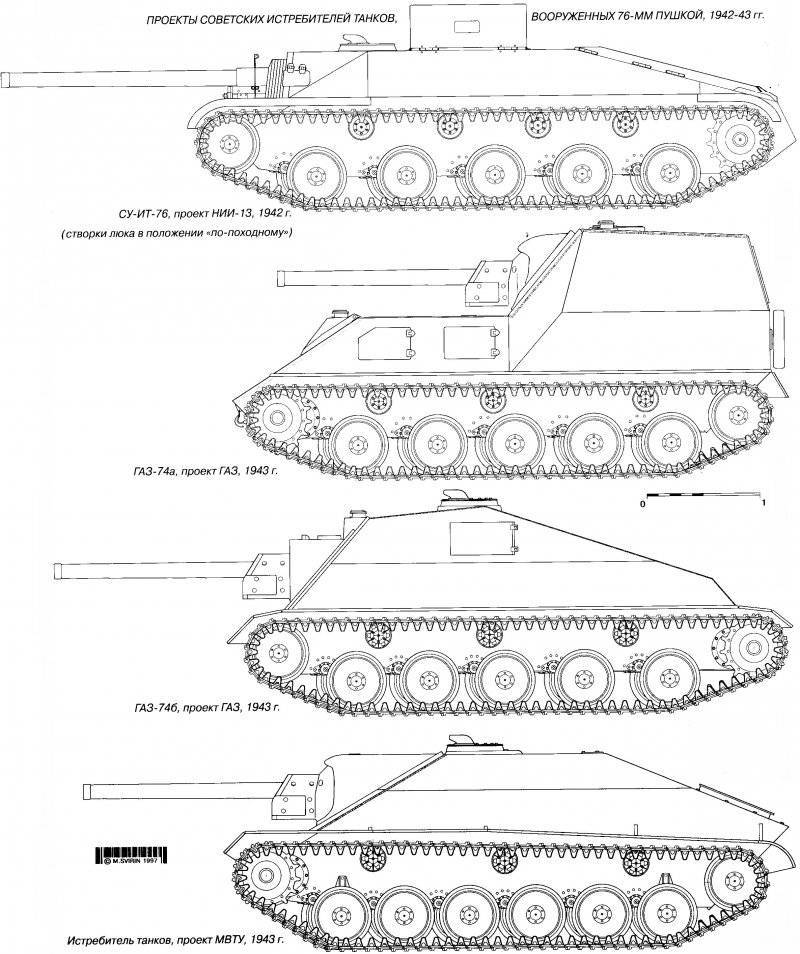
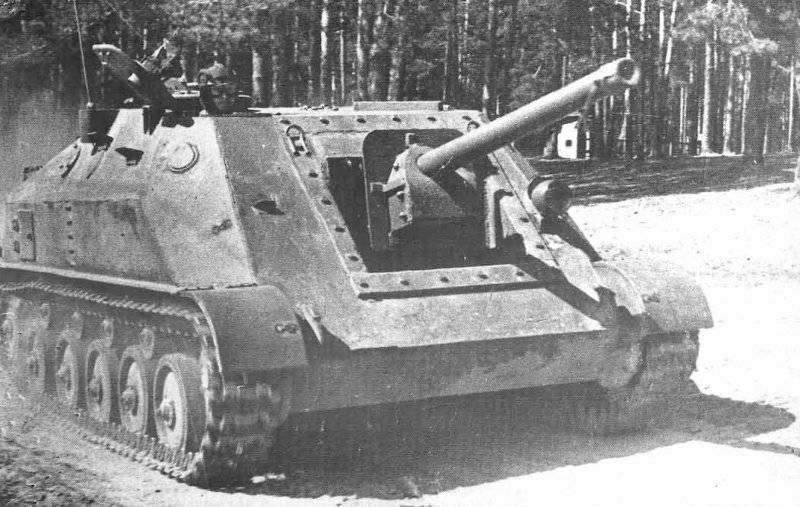
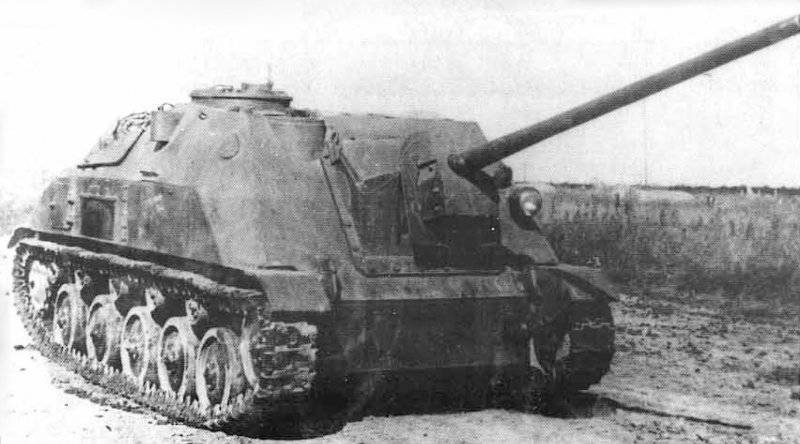
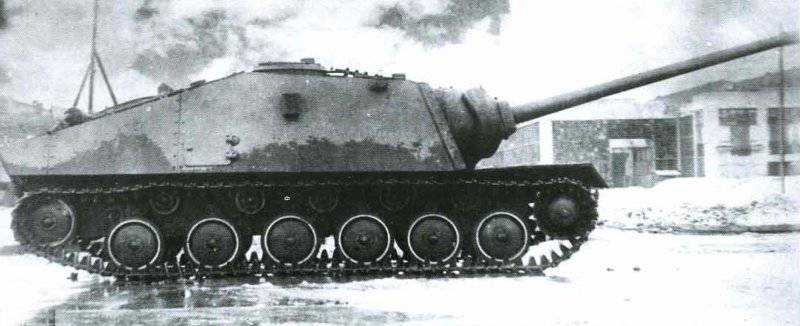
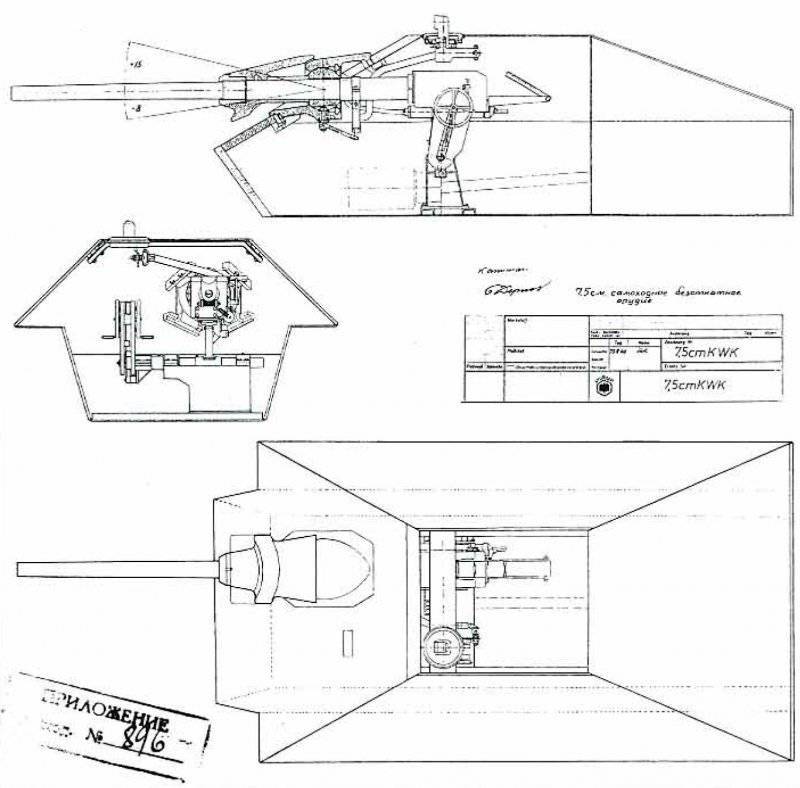
Information